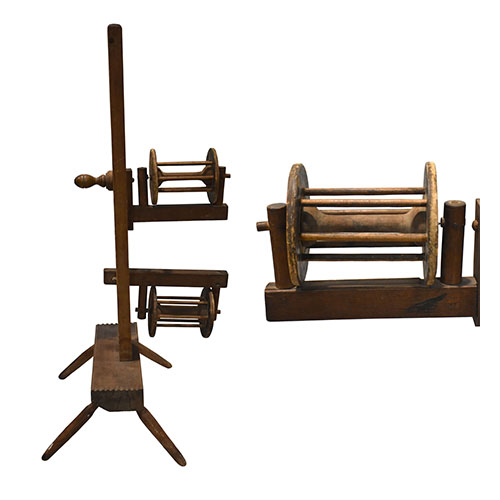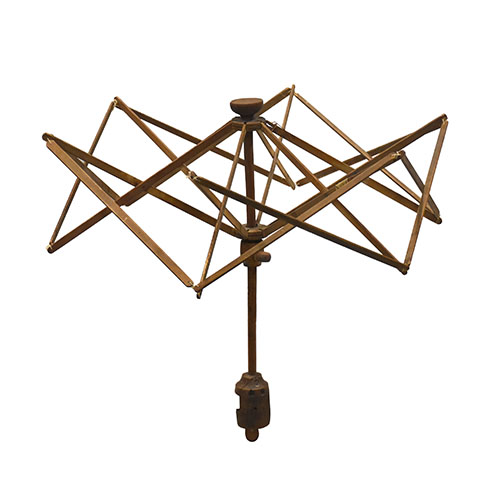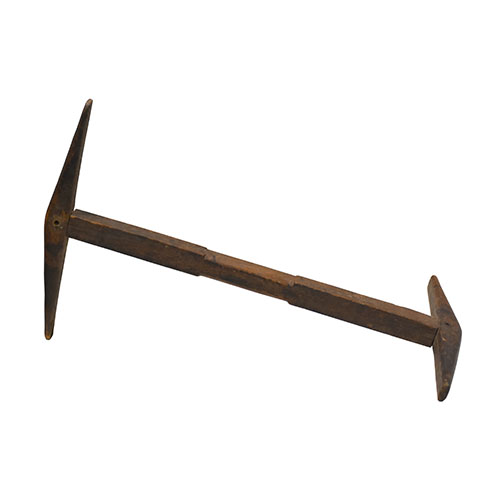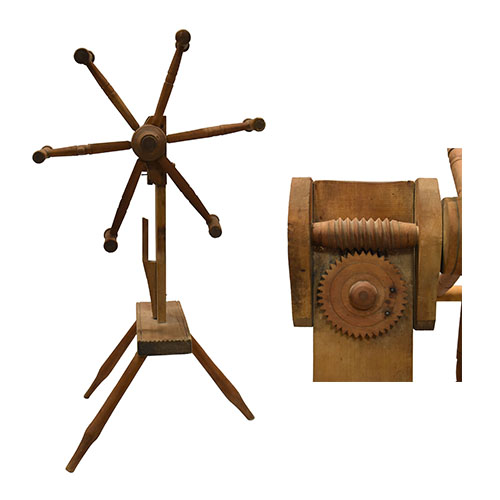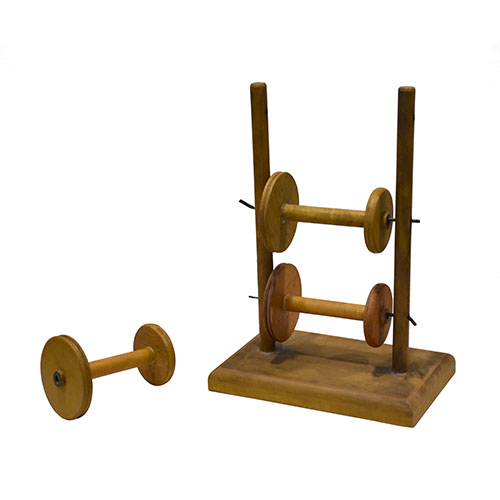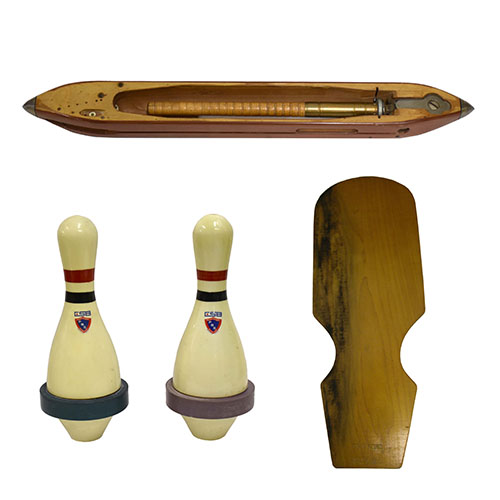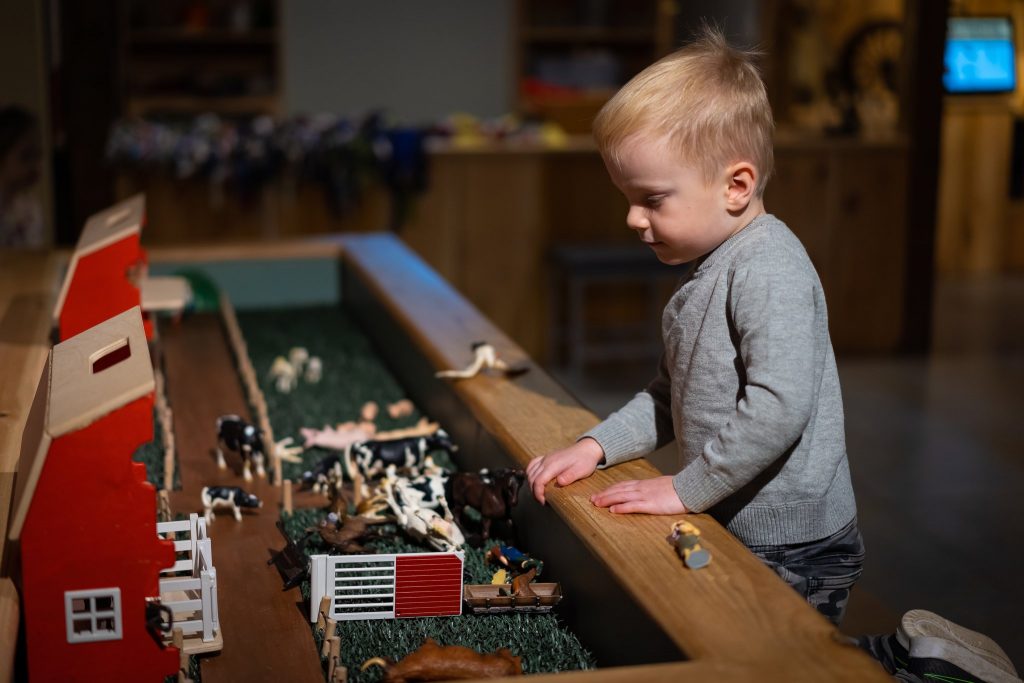History shows people across the globe, often independent of one another, had the same innovative ideas when it came to creating technology and tools to take raw materials and create cordage and fabric. Some of these devices are considered simple such as drop whorls or spindles that stretched the first plant and animal fibres into threads, later followed by spinning wheels and other industrial devices of the modern age.
Within the collection of the Bruce County Museum &Cultural Centre there are several types of spinning wheels indicating the diverse designs one piece of technology can have. Also found within the collection are several devices that are used after the first yarns have been made and are sitting finished on the bobbin of a spinning wheel. Like the wheels, these devices serve several of the same functions, but the forms they come in are diverse indicating the creativity of the makers. It begs the question: How many ways can you wind yarn?
Plying
Plying is the act of integrating two or more finished yarns together to create one thicker/stronger yarn by spinning them together. Simplified, this requires the two or more yarns to be spun through a spinning wheel together. A key part of this process is not having the yarns knotting together before they are spun, and they need to be put through with equal tension.
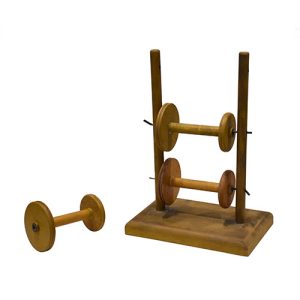 The solution to those problems is a device known as a lazy kate or bobbin caddy. Like the one seen here from the museum’s collection, lazy kates are frames in which several bobbins can be placed. This lazy kate has the potential to hold three bobbins, allowing for the creation of three-ply yarn. Sitting on a central shaft, the bobbins are free to make full rotations, allowing a spinner to draw all yarns at the same time into the spinning wheel, without them crossing and tangling with each other. Lazy kates come in a variety of styles, some with vertical rather than horizontal bobbin holders, and others have a central I-hook the yarns are fed through to ensure no snagging.
The solution to those problems is a device known as a lazy kate or bobbin caddy. Like the one seen here from the museum’s collection, lazy kates are frames in which several bobbins can be placed. This lazy kate has the potential to hold three bobbins, allowing for the creation of three-ply yarn. Sitting on a central shaft, the bobbins are free to make full rotations, allowing a spinner to draw all yarns at the same time into the spinning wheel, without them crossing and tangling with each other. Lazy kates come in a variety of styles, some with vertical rather than horizontal bobbin holders, and others have a central I-hook the yarns are fed through to ensure no snagging.
Creating Skeins or Hanks
Skeins are cylindrical balls of yarn and are typically the form in which yarn is purchased today. Once spinners have filled a bobbin on their spinning wheel, it needs to be put into a practical form for storage. Skeins or hanks are often a particular length, so to create them the device needs not only to put the yarn in a particular form, but it also needs to allow the user to measure at the same time.
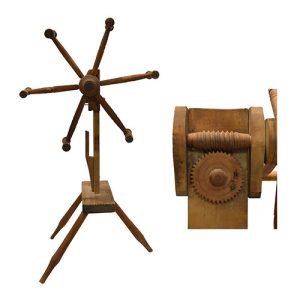 A yarn winder performs this duty. One of the most often seen forms in Canada is shaped like a ship’s wheel, or windmill, like the one pictured here. The measurement of the circumference of the arms is multiplied by the number of revolutions to measure the desired length. This wool winder has the added feature of an apparatus known as a weasel, which clicks when a full revolution of the wheel has occurred. On the side gear are two small metal pegs, which once the gear has made a full revolution would have butted up against a piece of wood making a clicking sound. The user would then count the number of clicks to keep track of how many full rotations of the winder they had made. Unfortunately, though the pegs can be seen on the gear, the weasel on this winder has broken off. Winders with weasels can also be referred to as click reels, spinners weasels, Clockenhen, or clock reels.
A yarn winder performs this duty. One of the most often seen forms in Canada is shaped like a ship’s wheel, or windmill, like the one pictured here. The measurement of the circumference of the arms is multiplied by the number of revolutions to measure the desired length. This wool winder has the added feature of an apparatus known as a weasel, which clicks when a full revolution of the wheel has occurred. On the side gear are two small metal pegs, which once the gear has made a full revolution would have butted up against a piece of wood making a clicking sound. The user would then count the number of clicks to keep track of how many full rotations of the winder they had made. Unfortunately, though the pegs can be seen on the gear, the weasel on this winder has broken off. Winders with weasels can also be referred to as click reels, spinners weasels, Clockenhen, or clock reels.
Another smaller device for creating skeins or hanks is the niddy noddy. Niddy noddys are handheld devices consisting of a central shaft with an arm at each end. The arms are perpendicular to one another. The user then winds the yarn around the arms while holding the niddy noddy in the middle. To ensure the yarn follows the winding pattern, the user tips their arm up and down, changing the central shaft from a vertical to horizontal position in a nodding fashion; many sources attribute the name niddy noddy to have come from said motion.
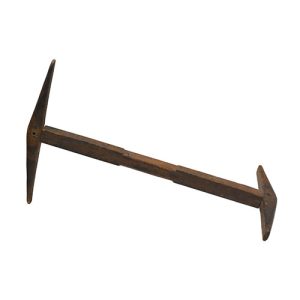 Like the ship’s wheel winder, the niddy noddy is made at a particular length and allows the user to measure as they are creating the skein or hank. The circumference of a skein using a niddy noddy is approximately four times the length of the shaft. This niddy noddy in the museum’s collection has a length of 47cm which would create a skein with an approximate circumference of 188cm. Knowing this, the user would then know how many cycles they would need to wrap the yarn to create the desired length.
Like the ship’s wheel winder, the niddy noddy is made at a particular length and allows the user to measure as they are creating the skein or hank. The circumference of a skein using a niddy noddy is approximately four times the length of the shaft. This niddy noddy in the museum’s collection has a length of 47cm which would create a skein with an approximate circumference of 188cm. Knowing this, the user would then know how many cycles they would need to wrap the yarn to create the desired length.
An advantage of using a yarn winder or niddy noddy, is the tension and form of the yarn stays constant. This allows for more reliable measuring as well as less tangling. Skeins and hanks can be created manually, and usually requires two people – one of which needs to keep their arms/hands at a constant height and distance apart. Winders, though perhaps not complex by today’s standards, remove the factor of muscle fatigue, and allow one person to do a two-person job.
Unwinding Skeins or Hanks
As mentioned, skeins or hanks are convenient forms to store yarn in but are not always the desired form to be working from. Often this is due to the whole of the skein not being required for a particular project, or because other forms are required such as balls for knitting or onto shuttle quills or bobbins for weaving. The devices used to unwind skeins are known as swifts, and according to author Judith Buxton “swifts exhibit the widest range of styles and almost boundless ingenuity of construction”. Within the collection of the BCM&CC are two of the more visually interesting forms – the umbrella swift and the squirrel cage swift.
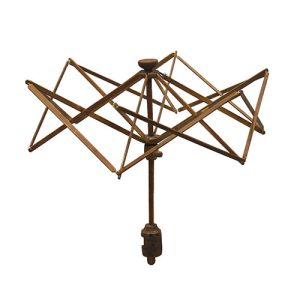 Like the name suggests, the umbrella swift appears in form much like the frame of an umbrella and functions the same way. As the frame is pushed up the central shaft, the larger the frame becomes. This allows the user to place a skein of any circumference onto the frame and make the minutest of adjustments. Many umbrella swifts have clamps on the bottom, like this one, which allows them to be clamped to table tops, and even to the seat of chairs. Unlike winders which have handles for the user to turn it pulling the yarn on, swifts lack handles, but still rotate. The rotation allows the yarn to be pulled off with little difficulty.
Like the name suggests, the umbrella swift appears in form much like the frame of an umbrella and functions the same way. As the frame is pushed up the central shaft, the larger the frame becomes. This allows the user to place a skein of any circumference onto the frame and make the minutest of adjustments. Many umbrella swifts have clamps on the bottom, like this one, which allows them to be clamped to table tops, and even to the seat of chairs. Unlike winders which have handles for the user to turn it pulling the yarn on, swifts lack handles, but still rotate. The rotation allows the yarn to be pulled off with little difficulty.
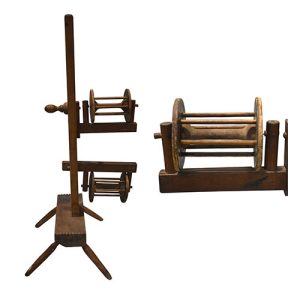 The squirrel cage swift consists of two round spoked cages or barrels which a skein is wrapped around. Like the umbrella swift, this one is adjustable, with the top cage bracket able to move up and down the central arm. With the central arm 53cm in height, this squirrel cage swift could accommodate a skein with a 166.4cm circumference. It has been noted this style of swift could also be used in plying, functioning like a large a lazy kate if different skeins are wrapped around each cage.
The squirrel cage swift consists of two round spoked cages or barrels which a skein is wrapped around. Like the umbrella swift, this one is adjustable, with the top cage bracket able to move up and down the central arm. With the central arm 53cm in height, this squirrel cage swift could accommodate a skein with a 166.4cm circumference. It has been noted this style of swift could also be used in plying, functioning like a large a lazy kate if different skeins are wrapped around each cage.
Though not wholly comprehensive of all the ways or forms to wind yarn, the collection of the BCM&CC shows variety within this genre of tools and includes popular Canadian settler forms such as the ship’s wheel or windmill winder. These tools vary in form ranging in shape and size from handheld to floor based and carry interesting names, showcasing the ingenuity of makers and users. From plying to preparing it for use, the answer to the question “How many ways can you wind yarn?”, is not as simple as it sounds.
Sources:
Buxton, Judith. “Selected Canadian Spinning Wheels in Perspective: An Analytical Approach”. Hull, Quebec: The Canadian Museum of Civilization, 1992. Print.
Cooper, Megan. “Antique Yarn Winder: A Complete Guide”. https://antiques.lovetoknow.com/antique-yarn-winder, 2022. Accessed March 2023.
Tyler, Amy. “Lazy Kates: Beginner Basics”. https://spinoffmagazine.com/lazy-kates-beginner-basics/, 2021. Accessed March 2023

